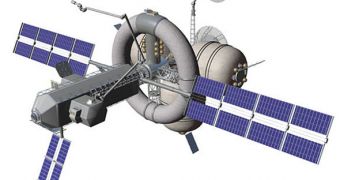NASA Johnson Space Center (JSC) experts Mark Holderman and Edward Henderson recently proposed a new spacecraft design to the agency's Future in Space Operations (FISO) group, that blew many people's minds away.
The team developed the Non– Atmospheric Universal Transport Intended for Lengthy United States (Nautilus) – X-ploration Multi-Mission Space Exploration Vehicle (MMSEV), a space probe/station that would operate exclusively in space.
According to the JSC experts, a lot of emphasis was placed on versatility and adaptability. The spacecraft was designed in such a manner that it could be used for a wide variety of missions, ranging in time spent in orbit from 1 month to 2 years.
In this sense, it could also be used for space exploration beyond low-Earth orbit. In two years, it could get to Mars and back. What's even more amazing is that it could carry a permanent crew of six.
On the basic skeleton of the machine, the JSC scientists envision docks for space capsules, and for descent and return vehicles. The Nautilus-X would feature no propulsion systems of its own.
Instead, it would be outfitted with mission-specific propulsion units depending on needs. Basically, it would be like attaching the required engine to a boat, before taking it out for a spin.
Also attached to the main structure, Holderman and Henderson envision numerous service modules, including also inflatables. Companies such as Bigelow Aerospace have already produced the first such modules, and tested them in space.
The two also propose that the main body of the spacecraft be outfitted with a ring centrifuge, that would allow astronauts to experience at least a little bit of gravity. This would aid them in staying healthy over long term missions.
Concept testing and operational deployment for many of the technologies that would need to go on Nautilus-X, including the ring centrifuge, could be tested on the International Space Station (ISS).
The JSC experts are part of the NASA Technology Applications Assessment Team (TAAT), whose job is to analyze technologies that can advance space exploration in a short period of time, and with affordable costs.

 14 DAY TRIAL //
14 DAY TRIAL //